Eating Soup Dumplings in Shanghai? Xiao Long Bao are Only Half the Story
04 Jul 2014
This is the meal I've been waiting for—the main reason I felt compelled to make my wife re-visit Shanghai, in fact. Ever since having my first taste of a Xiao Long Bao—variously referred to as "soup dumplings" or "juicy steamed buns" on American Chinese menus—I've yearned to taste them at the source in Shanghai.
Why the love? Well, if you've yet to experience XLB (as those cool kids in the know like to refer to them in Tweets), they're made by gently folding a gelatin-rich filling into a thin round of stretchy wheat dough. The dough gets gathered up and pleated into a cute little swirled bun with a tiny nipple at the top. As the dumpling gets subsequently steamed, the gelatin-rich broth in the filling melts out, filling up the delicately steamed wrapper with savory soup, the meat forming a tender, springy ball inside. To eat them you pick them up with chopsticks, dip them gingerly into sauce,* then proceed by either nibbling off a corner of dough and sucking out the soup, or by downing the whole thing in one go, letting it burst in your mouth like a savory Chinese Gusher.
*Don't you just love a good Tom Swiftie?
But in Shanghai, XLB are only half of the soup dumping story. Sheng Jian Bao—fried soup dumplings—while a ubiquitous breakfast food or snack in Shanghai for at least the last century, live in the shadow of their far more famous steamed counterpart. This is unfortunate, because if anything. SJB are even tastier than XLB—at least when made right. They start with a slightly thicker dough that, just like XLB, get pleated around a gelatin-rich filling. They're subsequently cooked in large, covered cast iron pans filled with just enough water to steam them through. As the water evaporates, the dumplings begin to fry on their bottom surface. You end up with a tender, steamed, juice-filled bun with a golden-brown, crisply fried bottom.
The problem is that in the US, it's much more difficult to find good SJB than good XLB. Poor SJB are doughy, tough, and lacking in juice. Even good ones, like the Fried tiny Buns with Pork at Shanghai Cafe Deluxe (who also happen to serve the best soup dumplings in Manhattan's Chinatown) are hit and miss—sometimes they're tender and juicy, other times they're doughy and dry inside.
Just like XLB, they have an extremely short half life. If you aren't getting them fresh from the steamer, then you may as well not get them at all.
Fortunately, there's one street in Shanghai where you can taste both of these local specialties, their doorways just meters apart.
Jia Jia Xiao Long Bao
Jia Jia Xiao Long Bao, located at number 90 on Huanghe Road (an easy walk from People's Park) is a Shanghai institution, serving what many claim are the best soup dumplings in the city. We went on the advice of Ken Phang. A Serious Eater and long-time Shanghai resident, Ken makes a living opening resturants in Shanghai, so he knows whereof he speaks.

The place is all business, with a short line out the door, a short menu printed on the wall, and a cashier who takes orders and money before you get seated. You'd better know what you want before you sit down, because after you're seated, you'll have to eat, get up, wait on line again, and re-order if you want more.
I've noticed that many buildings in China have the same pattern of vertically-oriented, non-staggered, shiny white tiles on their facades that makes strolling down the street feel like you're walking inside a very large men's locker room.* Jia Jia has those same tiles on the inside as well, which makes you feel like you're eating inside a men's locker room. Which is to say, people are here for the food and the food only.
*this may be inducing some sort of Pavlovian response in little children, which would explain why they feel the need to pee on the streets.
After briefly consulting our Chinese-English dictionary app on my phone, we successfully place an order for a dozen pork dumplings, a dozen pork and crab dumplings, some sweet ginger sauce, and a bowl of what I believe is egg and seaweed soup.
As you walk past the register, you see a mini factory line of a half dozen people making dumplings.

Two people stand at one end of the table, tearing dough into small balls and passing them on to the next two folks, who roll out the soft, white dough into thin wrappers.
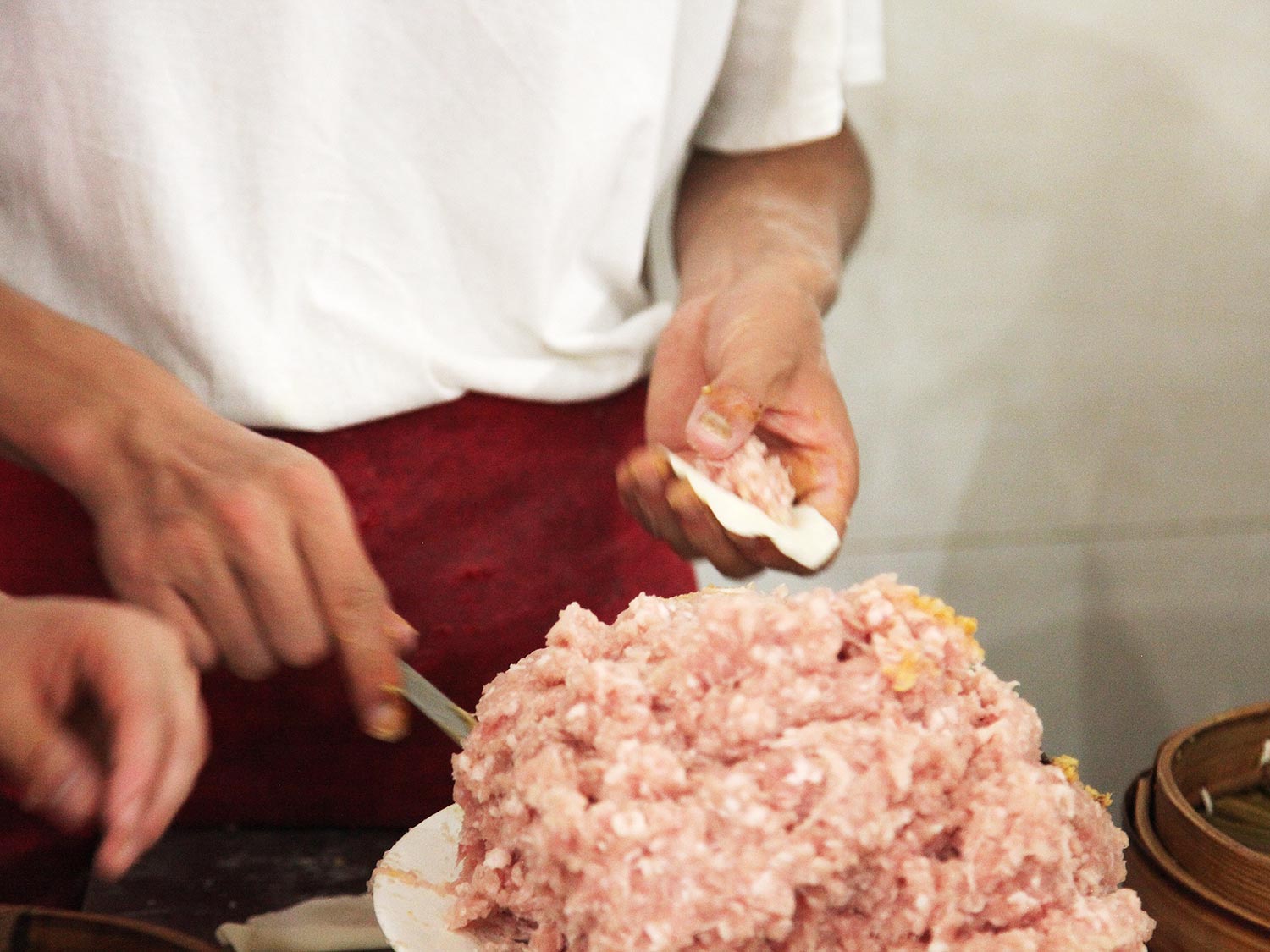
The wrappers are passed to the final set of hands, who use a thin pastry brush to dollop some raw filling into the center of the dough before crimping it up into a tiny purse.
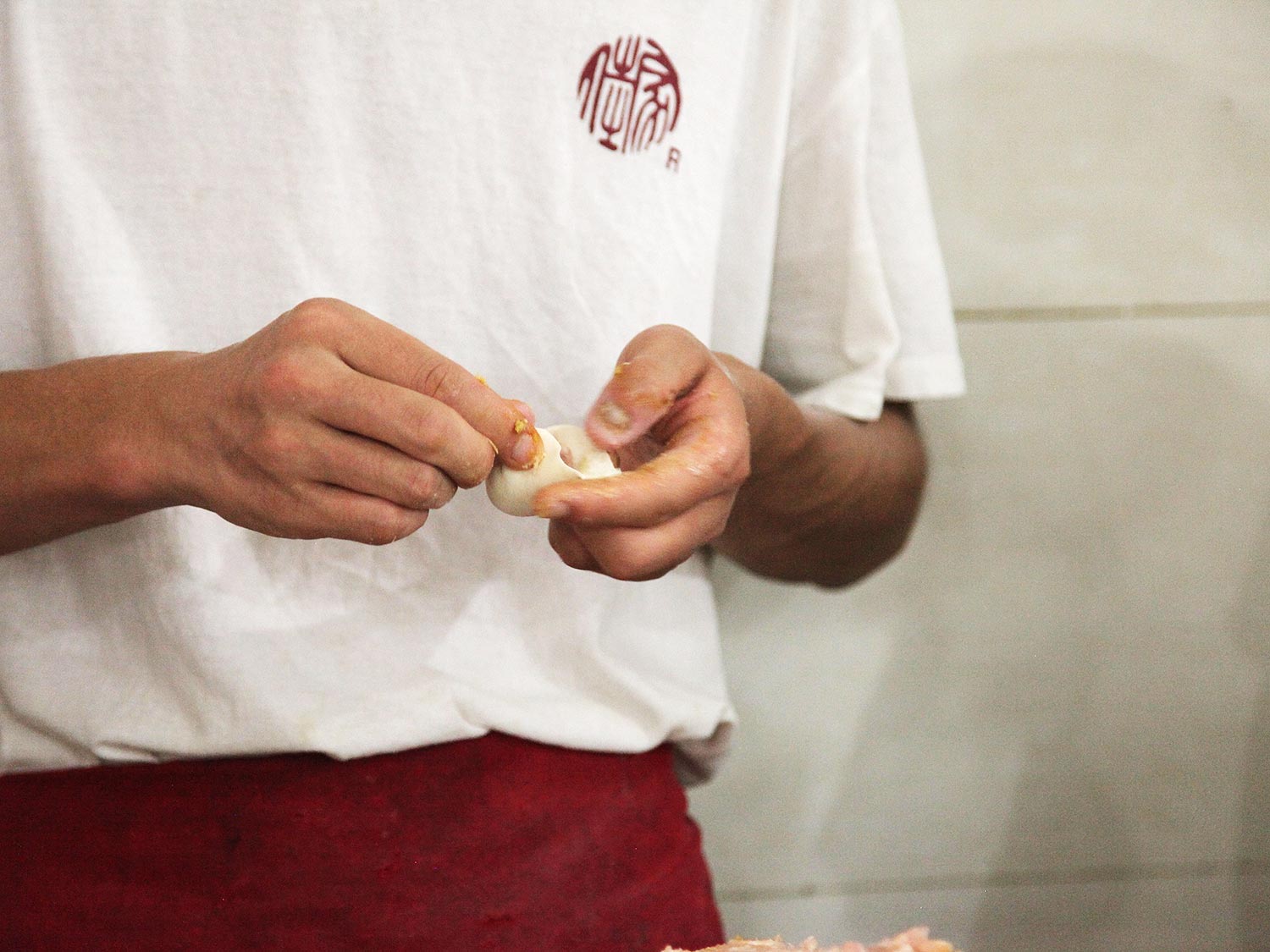
For anyone who's tried to make their own soup dumplings, now is the moment to be impressed. These guys are pros, churning out perfect little purses in seconds flat. Faster than Latino prep cooks at Shanghai Cafe Deluxe. Faster than the folks with sneeze-guards in the hospital-clean kitchens of Taiwanese chain Din Tai Fung. Super, super fast.
Now is when your mouth should start to water just a little bit.
We were seated and almost immediately brought a bowl of the soup.

Oops. Turns out I accidentally ordered the egg and blood soup, not the seaweed soup. Normally this wouldn't be a huge issue—I actually quite like blood—but I was very recently diagnosed with hemochromatosis, which means that I need to keep a watch on my iron intake. Blood is just about the worst thing I can eat. I ate one cube for the sake of research (tasty enough, though the broth was a little thin and bland), then let the soup be before the main event was delivered.

Let me cut to the chase: the pork dumplings here are the best soup dumplings I've had, period. Better than Din Tai Fung (at least the branch I visited in Tokyo), even (and at about a quarter of the price, I might add). Thin skins with just a slight bit of stretchy pull to them, tender, fatty pork with very minimal seasonings, and a broth with enough rich gelatin to get your lips sticky as you slurp them down.
The broth itself has quite a bit of sweetness going on, and this is compounded by the excellent ginger sauce, made with young ginger—not too spicy—vinegar, and sugar.
The crab and pork dumplings, which cost a premium, were also the best crab and pork soup dumplings I've had, but that's not saying much: crab soup dumplings inevitably taste like pre-cooked or canned crab with its unmistakable metallic, fishy tang. No thanks.
With our bellies full of XLB, Adri and I headed across the street to number 97 for a taste of SJB.
Yang's Fry-Dumpling
Another Shanghai institution, Yang's Fry-Dumpling has the same business-first attitude that Jia Jia has, the difference being that at Yang's, you can't even sit until you've picked up your food, and then, only if there are seats available. Adri and I ate our fried pork dumplings standing outside, leaning over a garbage can to catch the juices that dripped down our chins.
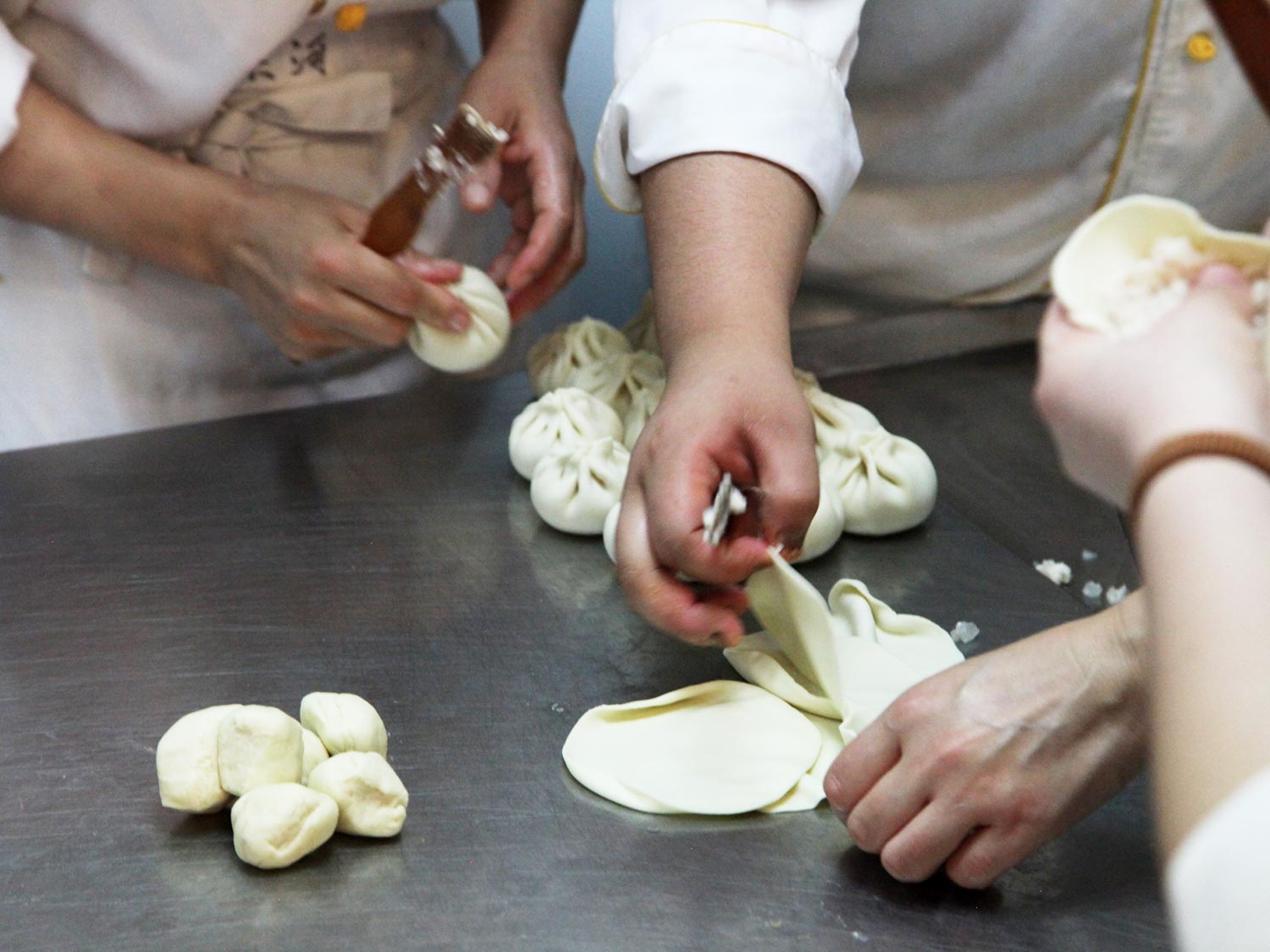
As at Jia Jia, you can watch the dumpling team at work as they stuff the buns.
Right away, you notice a major difference between the two. While XLB dough is rolled out super-thin on a floured surface, SJB dough is rolled thicker, and its rolled with oil rather than flour, much in the same way that Rou Jia Bing and other semi-leavened steamed bread doughs are.
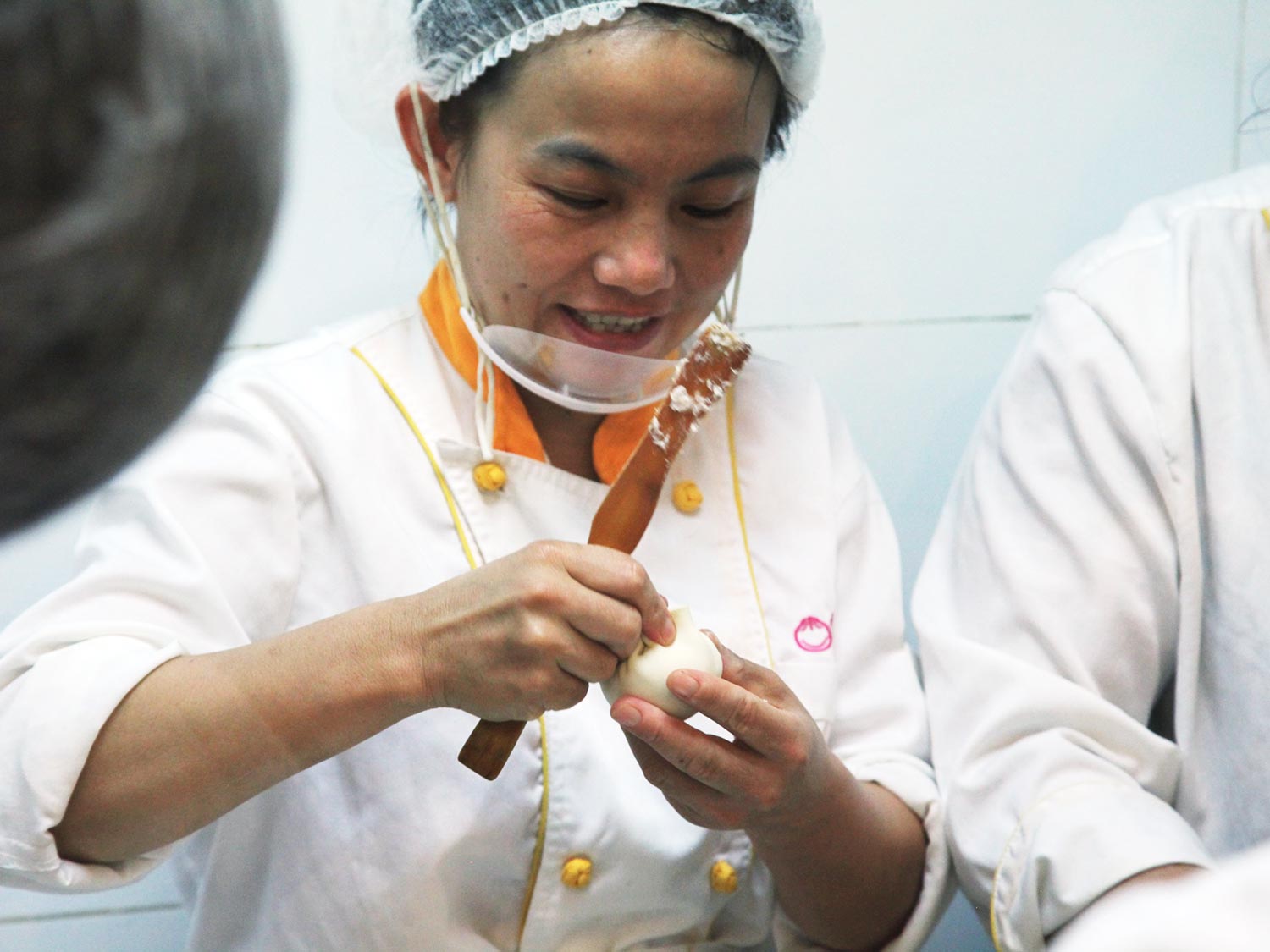
That said, the cooks are equally adept at stuffing and shaping the little dumplings, though the cooks at Yang's have an advantage: these buns are at least three times as large as a standard XLB.
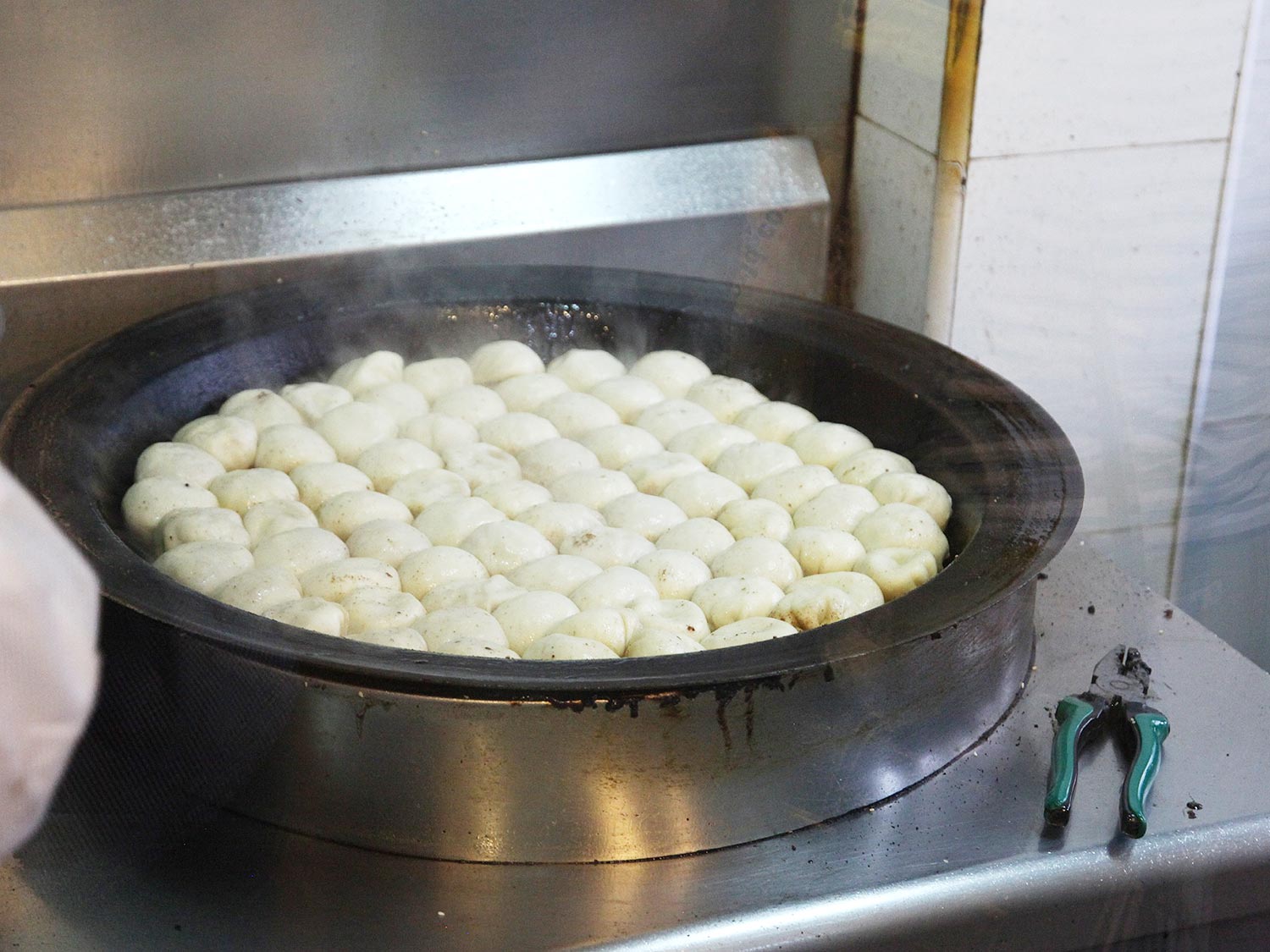
Once formed, the dumplings go nipple-side-downinto a large cast iron pan where they fry for a few brief moments before the cook dumps hot water over them.
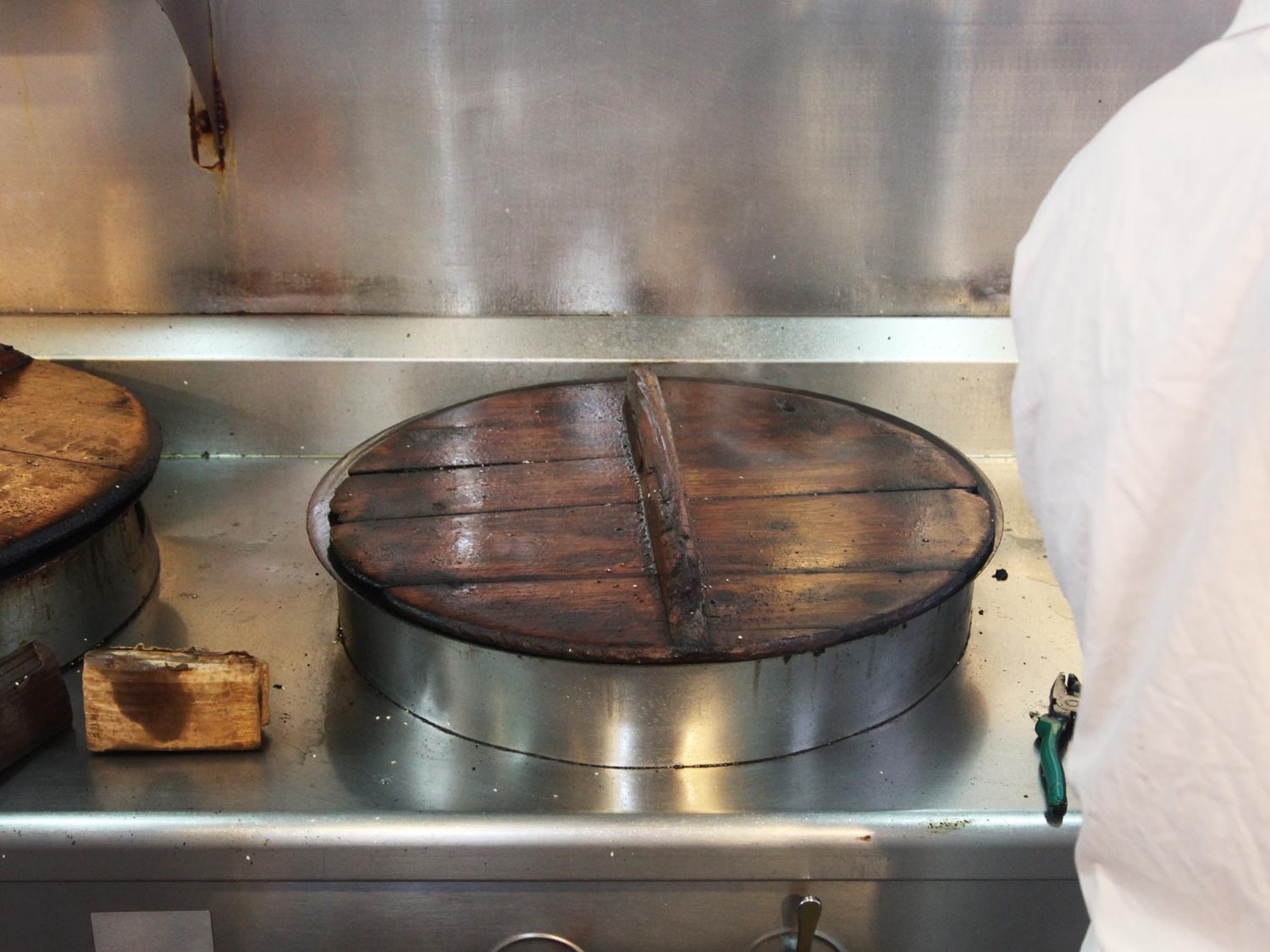
The pans are covered to allow the dumplings to steam through.
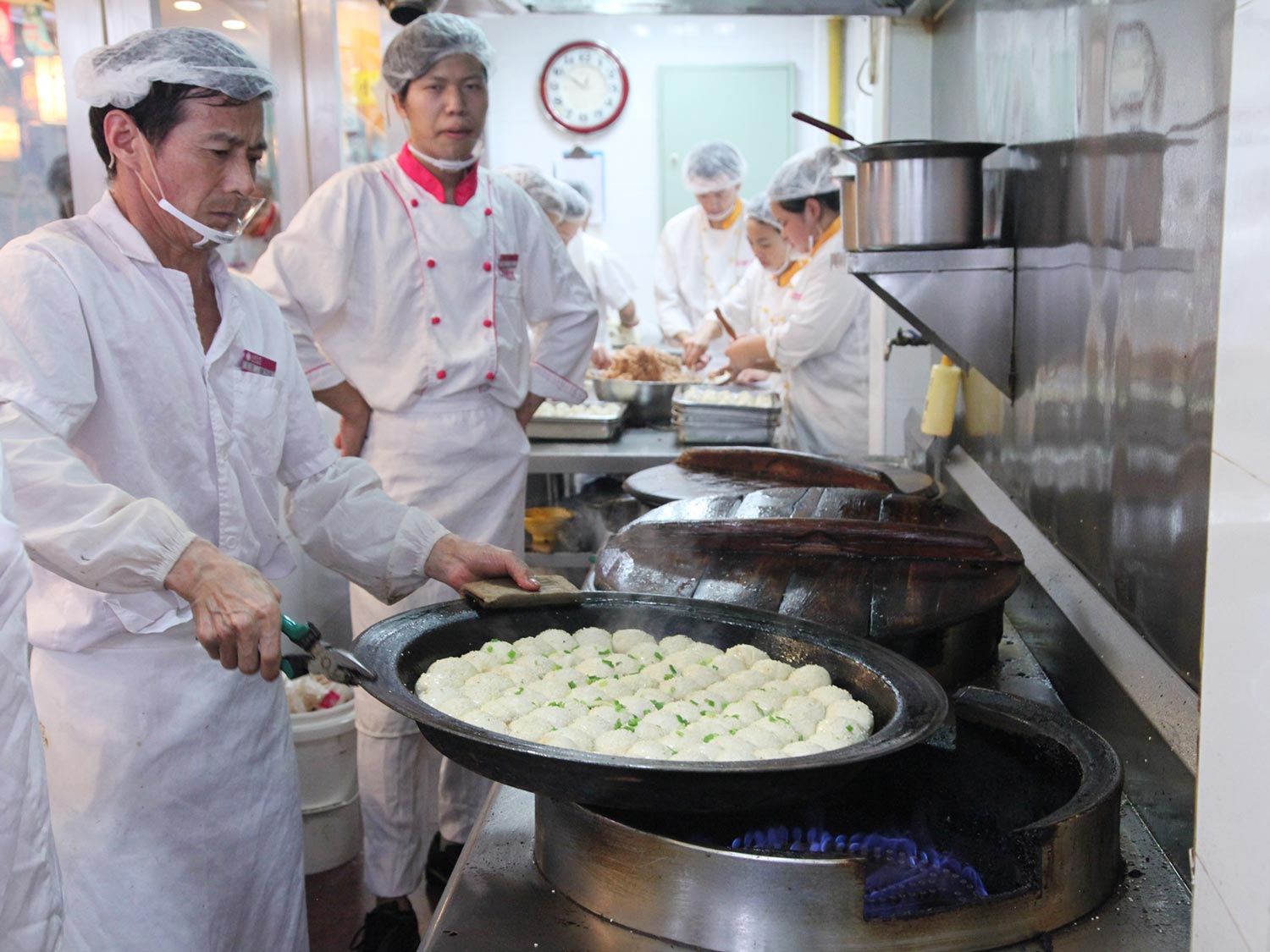
The dumplings cooks at Yang's work conveyer belt-style, shifting the pans along from one burner to the next as they go through each phase of the cooking process.
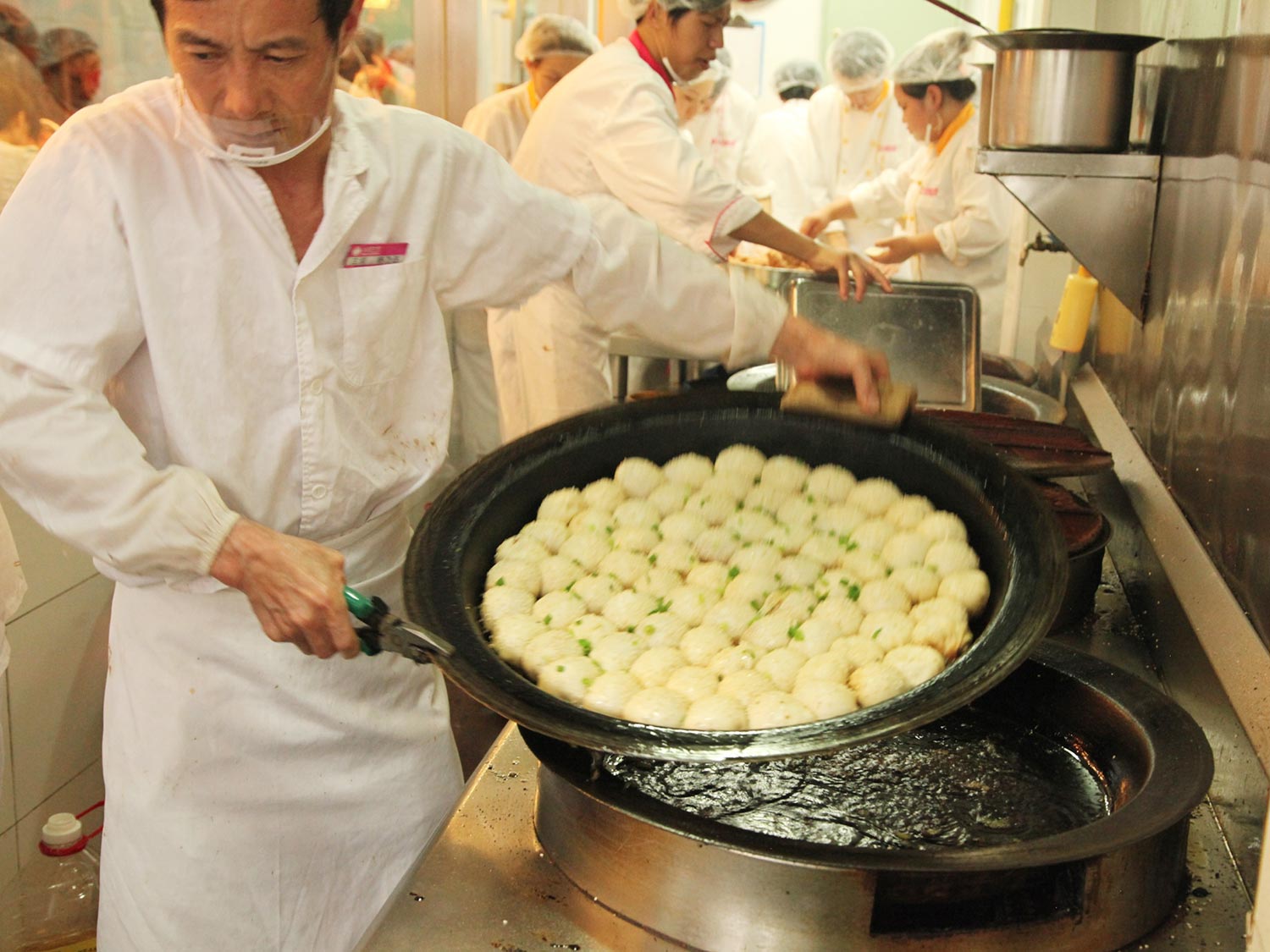
Eventually, as the water steams away, the dumplings begin to sizzle again as their bottoms brown.

By the time they reach the front window, they're ready for a sprinkle of black sesame seeds and scallions before being piled into plastic clamshells to hand off to customers.
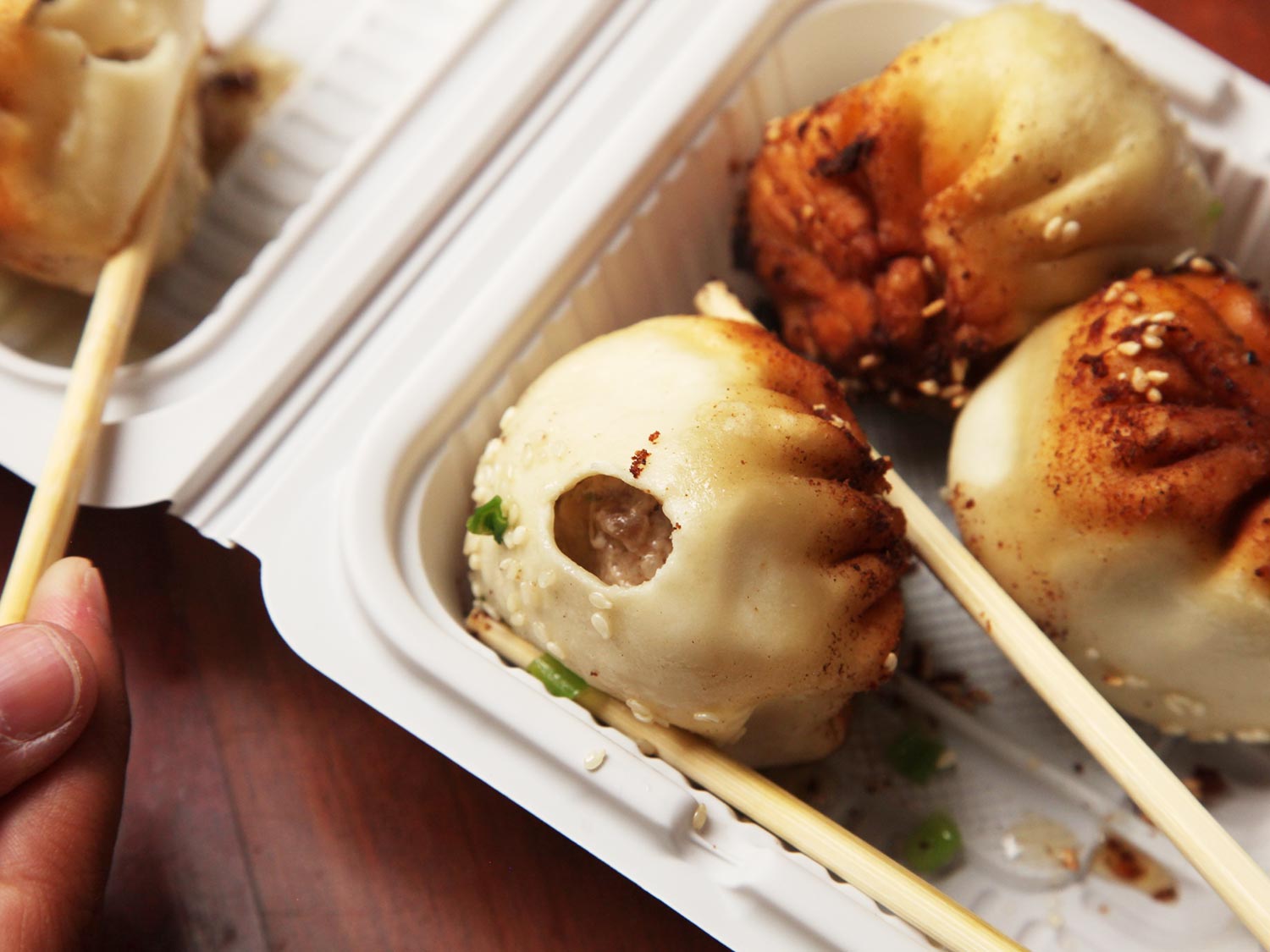
As with almost every other food experience I've had in China so far, these dumplings were pretty mindblowing, not only for hot awesome they were (and we'll get to that), but in how different they were from any version I'd had in the US.
In the US, the SJB you find are almost always made of the same dough that is used to make mantou—those puffy, steamed buns. The result is dumplings with a rather thick wrapper, with little bubbles of air trapped inside it like a sponge. Take a look at the bottom photo in this post about the Pan Fried Juicy Pork Buns at Philly's Dim Sum Garden for an idea of what I'm talking about.
That spongy wrapper, in turn, soaks up internal juice like, well, like a sponge, which means that unless you eat fast, the delicious soup inside ends up saturating the dumpling walls and disappearing.
The SJB at Yang's, on the other hand, have a much thinner skin with almost no leavening whatsoever. Its texture is not as elastic as a XLB, though its still pleasantly stretchy. The best part—aside from the soup inside, of course—is the crispy, crunchy, fried bottoms.
If someone would just go ahead and come out with a deep-fried soup dumpling that's crisp all over, I'd appreciate it, ok?
Pro-Tip: Skip the Giant XLB
You may have heard of the SOUP-DUMPLINGS-SO-BIG-YOU-NEED-A-STRAW-TO-DRINK-THE-SOUP-OUT-OF-THEM!!! that one can find in Shanghai. The restaurants that serve them mostly congregate around uber-touristy Yuyuan Bazaar south of the Bund. We headed there because ever since seeing them, Adri, a devout soup dumpling-lover, had to have one. After spotting a half dozen stores that sell them, we settled on one and ordered it.
This was Adri's face upon tasting:
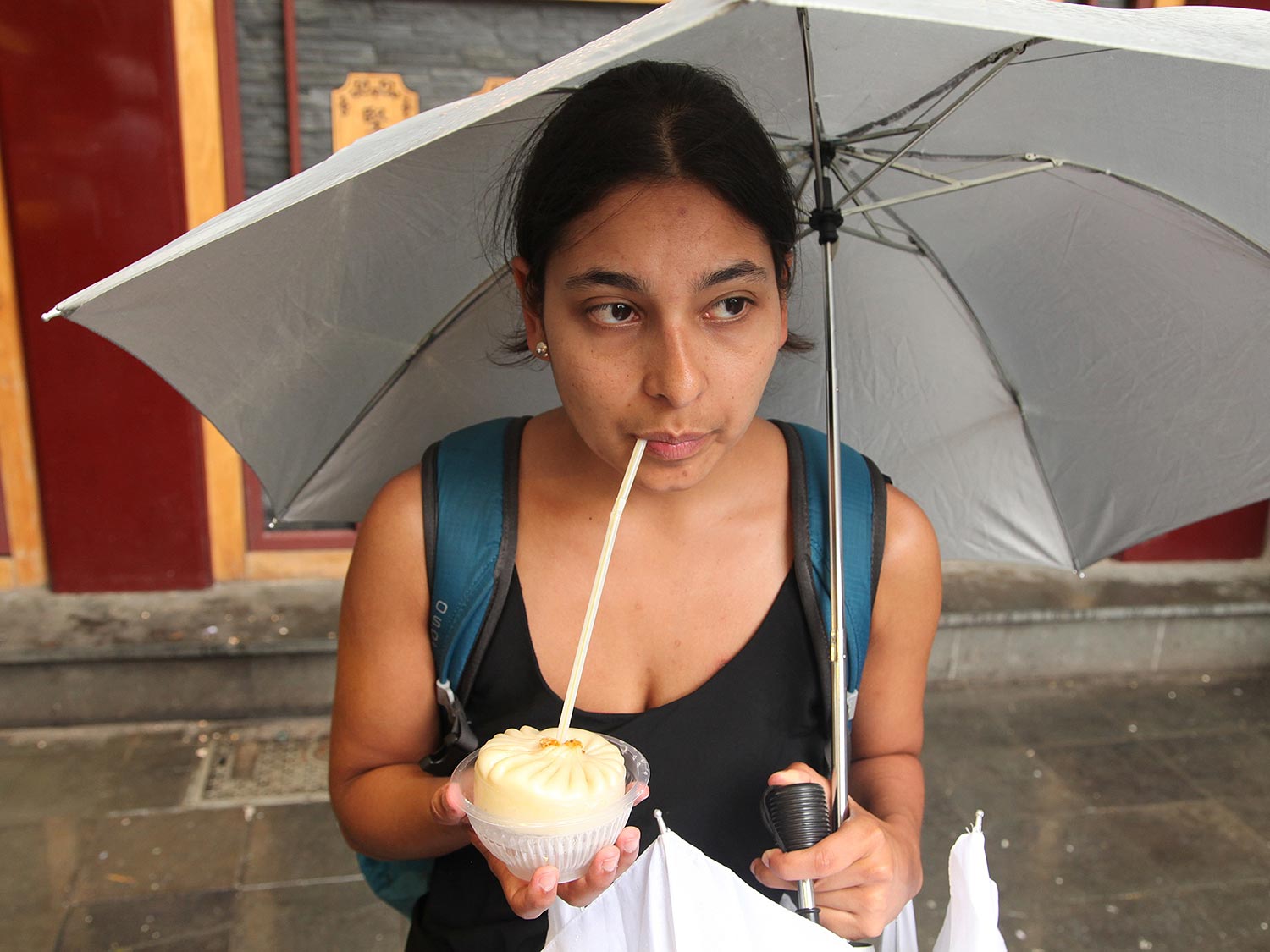
Yeah... they're pretty terrible. The soup itself was bland with an old crab flavor. The dumpling skin is so thick and plastic-like as to be completely inedible—I suppose they need to be in order to hold up to the amount of soup inside.*
*a great illustration of the square-cube law in action if ever there was one
We each had a couple of sips of bland broth, then tossed the rest away.
If you really must have a large, beige, liquid-filled treat served with a straw in Shanghai, you're better off with this:

Adri's also nuts about coconuts.